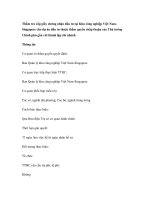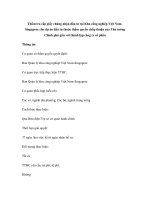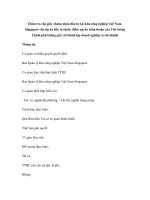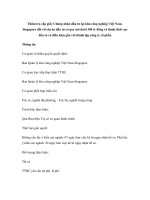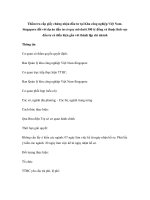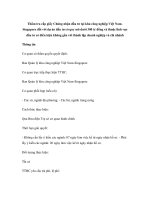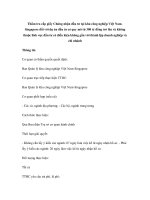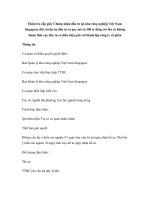Cây thuốc việt nam
Bạn đang xem bản rút gọn của tài liệu. Xem và tải ngay bản đầy đủ của tài liệu tại đây (323.96 KB, 8 trang )
Pseuderanthemum carruthersii var. atropurpureum TAØI LIEÄU THAM KHAÛO
-133-
TÀI LIỆU THAM KHẢO
TÀI LIỆU TIẾNG VIỆT
[1] Võ Văn Chi (1996), Từ điển cây thuốc Việt Nam, NXB. Y học, Hà Nội,
tr. 1353.
[2] Phan Minh Giang, Hà Việt Bảo, Phan Tống Sơn (2003), “Phytochemical
study on Pseuderanthemum palatiferum (Ness) Radlk., Acanthaceae”, Tạp chí
Hóa học, 41 (2), tr. 115118.
[3] Phan Minh Giang, Hà Việt Bảo, Phan Tống Sơn (2005), “Nghiên cứu hoạt
tính chống oxy hóa và khảo sát sơ bộ tác dụng kháng khuẩn, kháng nấm của
các phần chiết giàu flavonoid từ lá Xuân hoa, Pseuderanthemum palatiferum
(Ness) Radlk.”, Tạp chí Dược học, 9, tr. 912.
[4] Phạm Hoàng Hộ (2000), Cây cỏ Việt Nam, NXB. Trẻ, Tp. Hồ Chí Minh,
tr. 67.
[5] Nguyễn Văn Hùng, Lê Anh Tuấn, Nguyễn Quyết Chiến (2004), “Nghiên cứu
thành phần hóa học cây Xuân hoa, Pseuderanthemum palatiferum (Nees)
Radlk.”, Tạp chí Khoa học và Công nghệ, 2, tr. 7579.
[6] Trần Công Khánh, Nguyễn Văn Hùng, Nguyễn Thị Thanh Nhài, Lê Mai
Hương (1998), “Góp phần nghiên cứu về thực vật, thành phần hóa học và tác
dụng sinh học của cây Xuân hoa, Pseuderanthemum palatiferum (Nees)
Radlk.Acanthaceae”, Tạp chí Dược liệu, 3 (2), tr. 3742.
[7] Trần Công Khánh, Nguyễn Thị Minh Hằng, Đoàn Thị Mai Hương, Nguyễn
Văn Hùng (2007), “Nghiên cứu thành phần hóa học rễ cây Xuân hoa
(Pseuderanthemum palatiferum)”, Tạp chí Khoa học và Công nghệ, 45 (6), tr.
309314.
[8] Trần Kim Thu Liễu, Nguyễn Kim Phi Phụng (2007), “Contribution to the
study on chemical constituents of Pseuderanthemum palatiferum (Nees)
Radlk. (Acanthaceae)”, Tuyển tập các công trình Hội nghị Khoa học về Công
Pseuderanthemum carruthersii var. atropurpureum TAØI LIEÄU THAM KHAÛO
-134-
nghệ Hóa học Hữu cơ Toàn quốc lần thứ tư, NXB. Đại học Quốc gia Hà Nội,
tr. 426429.
[9] Xuân Lục (2005), “Cây thuốc diệu kỳ, Tu lình, cây thuốc nhiều tên nhiều tác
dụng”, Tạp chí về dược liệu và sức khỏe cộng đồng, 2, tr.2223.
[10] Lê Thị Lan Oanh, Võ Hoài Bắc, Nguyễn Văn Thiết, Nguyễn Thị Dung, Hoa
Thị Hằng, Trần Thị Thơm (1999), “Khảo sát một số chỉ tiêu sinh hóa và tác
dụng thủy phân protein của lá cây Xuân hoa, Pseuderanthemum palatiferum
(Nees)”, Tạp chí Dược liệu, 4 (1), tr. 1317.
[11] Nguyễn Thị Minh Thu, Trần Công Khánh, Trần Vân Hiền, Tạ Thị Phòng,
Trần Lê Dung (1999), “Thử độc tính cấp diễn và tác dụng bảo vệ tế bào gan
của cây Xuân hoa, Pseuderanthemum palatiferum (Ness) Radlk.”, Tạp chí
Dược học, 9, tr. 1517.
[12] Nguyễn Thị Minh Thu, Trần Công Khánh, Nguyễn Văn Hùng (2000), “Góp
phần nghiên cứu thành phần hóa học trong lá cây Xuân hoa”, Tạp chí Dược
liệu, 5 (6), tr. 163167.
[13] Mai Đình Trị, Lê Tiến Dũng, Nguyễn Công Hào, Phan Phước Hiền (2005),
“Triterpenoid và steroid phân lập từ lá cây Xuân hoa, Pseuderanthemum
palatiferum, Acanthaceae”, Tuyển tập các công trình Hội nghị Khoa học về
Công nghệ Hóa học Hữu cơ Toàn quốc lần thứ ba, NXB. Đại học Quốc gia
Hà Nội, tr. 422425.
TÀI LIỆU TIẾNG ANH
[14] Charles. J. Pouchert, Jacqlynn Behnke (1993), The Aldrich library of
13
C and
1
H FTNMR spectra, 3, Aldrich Chemical Company, Inc., pp. 365A.
[15] Chen Xie, Nigel C. Veitch, Peter J. Houghton, Monique S. J. Simmonds
(2003), “Flavones Cglycosides from Viola yedoensis MAKINO”, Chem.
Pharm. Bull., 51 (10), pp.12041207.
[16] Christie A. Boros, Frank R. Stermitz (1990), “Iridoid and update review. Part
I”, J. Nat. Prod., 53 (5), pp. 10551147.
Pseuderanthemum carruthersii var. atropurpureum TAØI LIEÄU THAM KHAÛO
-135-
[17] ChungYi Chen, TungYing Wu, FangRong Chang, YangChang Wu
(1998), “Lignans and kauranes from the stems of Annona cherimola”, Journal
of the Chinese Chemical Society, 45, pp. 629634.
[18] Dieu HK., Loc CB., Yamasaki S. (2006), “The effects of Pseuderanthemum
palatiferum, a new medicinal plant, on growth performances and diarrhea of
piglets”, Japa. Agri. Res. Qua., 40 (1), pp. 8591.
[19] Dilek Ercil, M. Koray Sakar (2004), “Chemical constituents of Linaria
aucheri”, Turk. J. Chem., 28, pp. 133139.
[20] Ellman G.L., Courtney D., Andres V., Featherstone M. (1961), “A new and
rapid colorimetric determination of acetylcholinesterase activity”,
Biochemical Pharmacology, 7, pp. 88–95.
[21] Fu G. M., Pang H. H., Wong Y. H. (2008), “Naturally Occuring
Phenylethanoid Glycoside: Potential Leads for New Therapeutics”, Curr.
Med. Chem., 15(25), pp. 2592-2613.
[22] Henrik Fischer W. Jensen, Soren Rosendal Jensen, Bent Juhl Neilsen (1987),
“Eranthemoside, a new iridoid glucoside from Eranthemum pulchellum
(Acanthaceae)”, Phytochemistry, 26 (12), pp. 33533354.
[23] Henrik Fischer W. Jensen, Soren Rosendal Jensen, Bent Juhl Neilsen (1988),
“Chemotaxonomy of the Acanthaceae. Iridoids and quaternary amines”,
Phytochemistry, 27 (8), pp. 25812589.
[24] Henrik Franzyk, Sren Rosendal Jensen, Zia Thale, Carl Erik Olsen (1999),
“Halohydrins and polyols derived from antirrhinoside: structural revisions for
muralioside and epimuralioside”, J. Nat. Prod., 62, pp. 275278.
[25] Hideaki Otsuka (1993), “Iridoid glucosides from Linaria japonica”,
Phytochemistry, 33 (3), pp. 617–622.
[26] Hiroki Tsukamoto, Sueo Hisada, Sansei Nishibe (1984), “Lignans from bark
of Fraxinus mandshurica var. japonica”, Chem. Pharm. Bull., 32 (11), pp.
44824489.
Pseuderanthemum carruthersii var. atropurpureum TAØI LIEÄU THAM KHAÛO
-136-
[27] Hiromi Kobayashi, Hiroko Karasawa, Toshio Miyase, Seigo Fukushima
(1984), “Studies on the constituents of Cistanchis Herba. IV. Isolation and
structures of two new phenylpropanoid glycosides, cistanosides C and D”,
Chem. Pharm. Bull., 32 (10), pp. 38803885.
[28] Hiroshi Sasaki, Heihachiro Taguchi, Tohru Endo, Itiro Yosioka, Kimio
Higashiyama, Hirotaka Otomasu (1978), “The glycosides of Martynia
louisiana Mill.. A new phenylpropanoid glycoside, martynoside”, Chem.
Pharm. Bull., 26 (7), pp. 2111–2121.
[29] Ihsan Calis, Mohamed F. Lahloub, Erich Rogenmoser, Otto Sticher (1984),
“Isomartynoside, a phenylpropanoid glycoside from Galeopsis pubescens”,
Phytochemistry, 23 (10), pp. 23132315.
[30] Ihsan Calis, Saracoglu, Ahmet Basaran A., Otto Sticher (1993), “Two
phenethyl alcohol glycosides from Scutellaria orientalis subsp. pinnatifida”,
Phytochemistry, 32 (6), pp. 16211623.
[31] Isabel SampaioSantos M., Auxiliadora M. Kaplan C. (2001), “Biosynthesis
significance of iridoids in chemosystematics”, J. Braz. Chem. Soc., 12 (2), pp.
144153.
[32] JingHua Yang, YunSong Wang, Liang Li (2006), “New polyoxygenated
triterpenoids from Stachyurus himalaicus var. himalaicus”, Helvetica
Chimica Acta, 89, pp. 28302835.
[33] Kotaro Takahashi, Toshie Nakagawa (1966), “Studies on constituents of
medicinal plants, the stereochemistry of paulownin and isopaulownin”, Chem.
Pharm. Bull., 14 (6), pp. 641647.
[34] Leska Marlies, Hiller K. (1988), “Flavone Cglycosides: a review”,
Pharmazie, 43 (5), pp. 305312.
[35] Li Ji Ren, Wang Bin, Qiao Liang, Al Tie Min, Zhao Yu Ying (2002), “Studies
on watersoluble constituents of Echinacea prupurea”, Acta Pharmaceutica
Sinica, 37 (2), pp. 121123.
Pseuderanthemum carruthersii var. atropurpureum TAØI LIEÄU THAM KHAÛO
-137-
[36] Lionello Pogliani, Maurizio Ceruti, Gabriele Ricchiardi, Davide Viterbo
(1994), “An NMR and molecular mechanics study of squalene and squalene
derivatives”, Chemistry and Physics of Lipids, 70, pp. 2134.
[37] Mai HD., Minh HN., Pham VC., Bui KN., Nguyen VH., Chau VM. (2011),
“Lignans and other constituents from the roots of Vietnamese medicinal plant
Pseuderanthemum palatiferum”, Planta Med., 77 (9), pp. 951954.
[38] Maillard M., Adewunmi C. O., Hostettman K. (1992), “A triterpene glycoside
from the fruits of Tetrapleura tetraptera”, Phytochemistry, 31, pp.
13211323.
[39] Moss G. P. (2000), “Nomenclature of lignans and neolignans”, Pure Appl.
Chem., 72 (8), pp. 14931523.
[40] Naowarut Kongkum, Jongkolnee Jongaramruong (2005), “Secondary
metabolites of the sea grasses Halodule pinifolia, Enhalus acoroides and
Halophila ovalis from Kung Krabaen Bay”, 31st Congress on Science and
Technology of Thailand at Suranaree University of Technology, 18 – 20
October 2005.
[41] Nazemiyeh, Maleki N., Mehmani F., Kumarasamy Y., Shoeb M., Garjani A.,
Sarker S.D. (2007), “Assessment of antiinflammatory properties of ethyl
acetate extract of Stachvs schtschegleevii Sosn.”, Daru, 15 (4), pp. 174182.
[42] Peerawit Padee, Somsak Nualkeaw, Chusri Talubmook, Supasorn
Sakuljaitrong (2009), “Acute toxicity and subacute toxicity of
Pseuderanthemum palatiferum”, Isan Journal of Pharmaceutical Sciences, 5
(1), pp. 7481.
[43] Peizhong Yu, Changqi Hu, Edward J. Meehan, Liqing Chen (2007), “Xray
crystal structure and antioxidant activity of salidroside, a phenylethanoid
glycoside”, Chemistry and Biodiversity, 4, pp. 508513.
[44] Pelter A., Ward R. S., Venkata E. and Sastry K. V. (1976), “Revised
structures for pluviatilol, methyl pluviatilol and xanthoxylol. General methods
